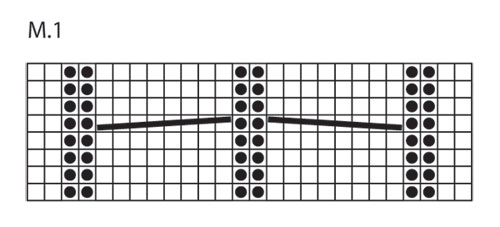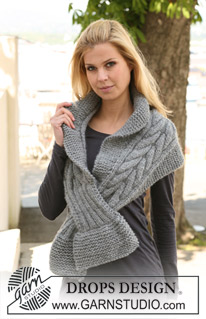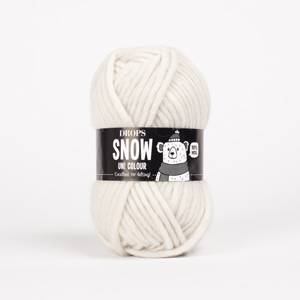Comments / Questions (48)
![]() ELisabeth wrote:
ELisabeth wrote:
Je suis gauchère et tricoter la deuxième partie en sens inverse me pose un véritable problème ! Merci de m'aider car je souhaite vraiment réaliser cette belle écharpe. Bien à vous
21.08.2018 - 16:06DROPS Design answered:
Bonjour Elisabeth, pour tricoter la 2ème partie, vous devez faire à droite ce que vous avez fait à gauche pour la 1ère partie et à gauche dans la 2èe partie ce que vous avez fait à droite pour la 1ère partie, les 2 pièces doivent être en miroir. Par ex, les rangs raccourcis du col se tricoteront en commençant sur l'endroit (les mailles sont au préalables rabattues sur l'envers). Votre magasin saura vous aider et vous conseiller si besoin, même par mail ou téléphone. Bon tricot!
03.09.2018 - 15:11
![]() Morera wrote:
Morera wrote:
Les explications de ce modèle drops125-19 ne donne pas les dimensions, surtout en longueur, pouvez vous me les indiquer? svp merci+++ par avance, sincères salutations
04.03.2016 - 22:39DROPS Design answered:
Bonjour Mme Morera, pour les dimensions, vous pouvez vous fier à la tension et aux explications ainsi qu'à la photo. Bon tricot!
07.03.2016 - 10:49
![]() Lilli Bruun wrote:
Lilli Bruun wrote:
Da jeg så den måtte jeg bare igang med pindene så flot og så anvenlig´glæder mig til den er færdig
06.01.2016 - 13:37
![]() Delaplanche wrote:
Delaplanche wrote:
Bonjour, Doit-on arrêter de tricoter en rangs raccourcis sur les mailles point mousse de chaque côté lorsque nous avons obtenu 53m au total après les augmentations ? Merci d'avance
15.03.2015 - 09:59DROPS Design answered:
Bonjour Mme Delaplanche, quand toutes les augmentations sont faites, on ne tricote plus les rangs raccourcis, mais on continue comme indiqué avec les diminutions et les mailles à rabattre, pus on tricote encore de nouveaux rangs raccourcis (3 m en moins tous les 2 rangs) jusqu'au milieu dos. Bon tricot!
16.03.2015 - 09:08
![]() Gunilla Andersson wrote:
Gunilla Andersson wrote:
Jättesnygg! Jag skulle önska att kunna sticka den i tunnare garn. Finns något sådant mönster?
03.02.2015 - 19:00DROPS Design answered:
Hej Gunille, Inte just den, men du kan även söka efter ett sjal i garngrupp B som = 21 m på 10 cm. Lycka till!
04.02.2015 - 09:08
![]() Elke wrote:
Elke wrote:
Den Schal sieht auf dem Foto so toll aus, fiel bei mir aber viel zu klein und zu schmal aus. Auf dem Foto geht er weit über die Schultern - bei mir nicht mal bis an die Schultern. Außer dem Chart für den Zopf und dem fertigen Foto gibt es keine Bilder. Ein paar Absätze im Text würden die Verständlichkeit erleichtern. Vor allem sollten aber eine bemaßte Skizze eines fertigen Strickteils sowie eine gezeichnete Erklärung für die Zunahmen und die verkürzten Reihen ergänzt werden.
21.01.2015 - 06:48
![]() Fillatre wrote:
Fillatre wrote:
SVP peut on faire ce modele avec d autres laines, si oui proposez moi les couleurs ainsi que le nombres de pelotes de laine. MERCI
28.12.2014 - 02:19DROPS Design answered:
Bonjour Mme Fillatre, vous pouvez tout à fait utiliser une autre qualité que celle proposée dans les explications. Cliquez ici pour en savoir plus sur les équivalences, groupes et calcul des quantités. Les couleurs disponibles figurent sous chaque nuancier, votre magasin DROPS pourra vous conseiller si nécessaire. Bon tricot!
30.12.2014 - 13:44
![]() Ulrike Wulf wrote:
Ulrike Wulf wrote:
Hallo, bin jetzt fertig mit der Anleitung des ersten Teils und es sieht superschön aus. Ist aber nur 65 cm lang. Ist es nicht ein bisschen kurz, wenn der Schal insgesamt nur 1,30m wird?
15.12.2014 - 15:34DROPS Design answered:
Der Schal wird sich durch das Garngewicht noch ein bisschen aushängen und etwas länger werden. Die von Ihnen angegebene Maße passen aber auch in etwa zu der Länge des Schals, die Sie auf dem Foto sehen.
22.12.2014 - 00:00
![]() Lugert wrote:
Lugert wrote:
Ich habe lange nicht gestrickt und verstehe nicht alle Abkürzungen wie z.B. *2 re oder von *-*. Ich benötige eine Erklärung, warum 1 M re und 2 re, was ist der Unterschied.
23.11.2013 - 19:22DROPS Design answered:
Liebe Frau Lugert, wenn Ihnen die Grundlagen nicht mehr präsent sind, schauen Sie sich am besten alle relevanten Hilfsvideos zu dieser Anleitung an.
25.11.2013 - 07:58
![]() Schumacher wrote:
Schumacher wrote:
Hallo, lieben Dank für Ihre Hilfe. Ich habe den Fehler schon gefunden. Es lag an den Reihen, erst hatte ich 16 Reihen. Nun habe ich 8 Reihen und es stimmt. Nochmals Danke
30.10.2013 - 19:36
DROPS 125-19 |
|||||||||||||
|
|
|||||||||||||
DROPS scarf with cables in ”Snow”.
DROPS 125-19 |
|||||||||||||
|
PATTERN: See diagram M.1. Diagram shows the pattern from RS. GARTER ST (back and forth on needle): K all rows. -------------------------------------------------------- SCARF: Cast on 26 sts on needle size 8 mm with Snow. Work GARTER ST - see above - back and forth on needle for approx 12 cm. Change to needle size 7 mm. Continue in rib as follows (from RS): 2 garter sts, * K2, P2 *, repeat from *-* and finish with K2 and 2 garter sts until rib measures approx 15 cm. Change back to needle size 8 mm and work next row from RS as follows: 1 Garter st, 1 YO, 1 Garter st, 1 YO, K2, P2, K2, 1 YO, K2, 1 YO, K2, P2, K2, 1 YO, K2, 1 YO, K2, P2, K2, 1 YO, 1 Garter st, 1 YO and 1 Garter st = 34 sts. Work next row from WS as follows: 4 Garter sts, P2, K2, P8, K2, P8, K2, P2, 4 Garter sts. NOTE! Work YO into back of loop on return row. READ ALL OF THE FOLLOWING SECTION BEFORE CONTINUING! Insert a marker 4 sts in from each side and continue in M.1 between markers with garter st each side. AT THE SAME TIME inc the garter sts each side as follows (from RS): inc 1 st before the first marker on every 4th row and 1 st after the second marker on every 8th row. Continue like this until there are 17 sts before the first marker and 10 sts after the second marker (= a total of 53 sts). AT THE SAME TIME as beg M.1 also work shortened rows on the garter sts each side. Work back and forth 1 time on the garter sts at beg of every row from RS. And work back and forth 1 time on the garter sts at beg of every other row from WS (these rows each side are additional and not included with respect to the inc). When all inc are complete work 1 row from WS with K over K and P over P. Then K 1 row from RS on all sts, AT THE SAME TIME dec 2 sts on each cable (= 4 dec sts) = 49 sts. K 1 row from WS on all sts. Cast off 17 garter sts (= collar) at beg of row, work remaining sts on rows = 32 sts. Work garter st on the remaining sts with shortened rows as follows (row 1 = from WS): Work row until 3 sts remain on needle, turn piece, tighten thread and work return row. Work row until 6 sts remain on needle, turn piece, tighten thread and work return row. Continue like this with 3 sts more before each turn until you have worked back and forth on 2 sts only. Now work back and forth on all sts and cast off. Knit 1 more piece in the same way, but mirrored. ASSEMBLY: Sew the 2 pieces tog mid back, sew edge to edge in outer loops of sts to avoid a chunky seam. Pick up 26 sts on needle size 7 mm with Snow behind the rib on the right side. Continue as follows: 2 garter sts, * K2, P2 *, repeat from *-* and finish with K2 and 2 garter sts until rib measures approx 15 cm (adjust to the rib in front). Cast off with K over K and P over P. Sew the rib to the back of scarf. |
|||||||||||||
Diagram explanations |
|||||||||||||
|
|||||||||||||

|
|||||||||||||
Have you finished this pattern?Tag your pictures with #dropspattern or submit them to the #dropsfan gallery. Do you need help with this pattern?You'll find 14 tutorial videos, a Comments/Questions area and more by visiting the pattern on garnstudio.com. © 1982-2025 DROPS Design A/S. We reserve all rights. This document, including all its sub-sections, has copyrights. Read more about what you can do with our patterns at the bottom of each pattern on our site. |
|||||||||||||






















































Post a comment to pattern DROPS 125-19
We would love to hear what you have to say about this pattern!
If you want to leave a question, please make sure you select the correct category in the form below, to speed up the answering process. Required fields are marked *.